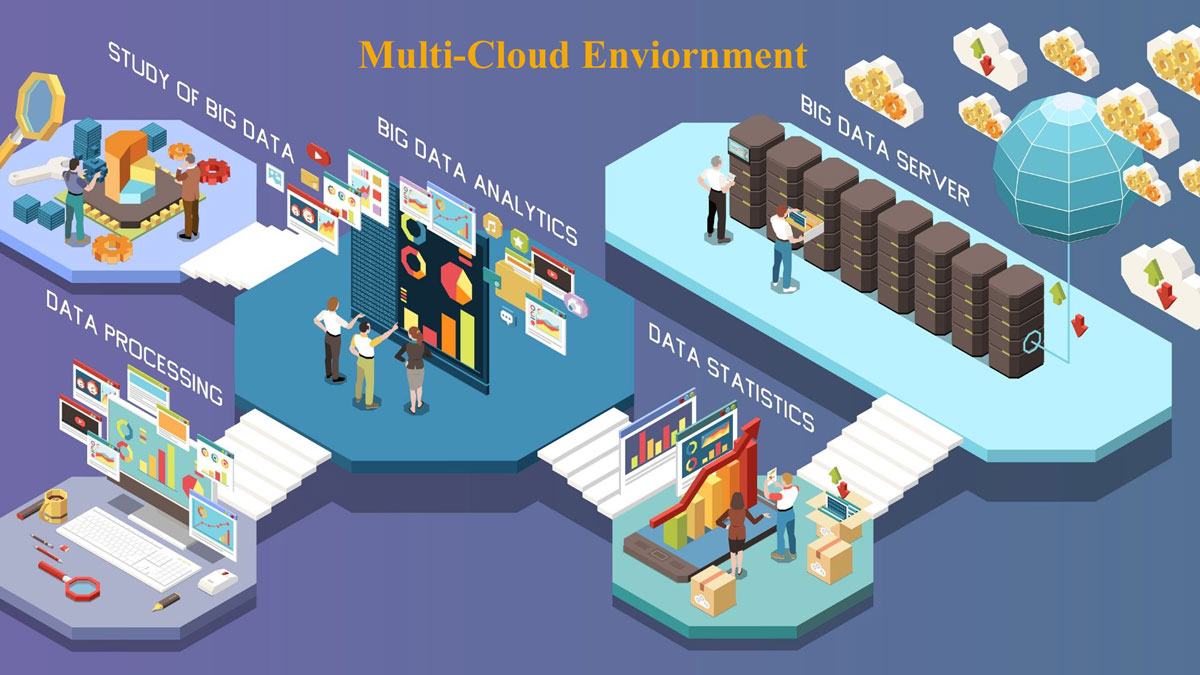7 Best Practices for managing a multi-cloud environment

Deep learning and machine learning specialist, well-versed with experience in Cloud infrastructure, Block-chain technologies and Big Data solutions.
February 21, 2020
Multi-Cloud Environment
Nowadays it is essential to create a multi-cloud environment as computing and storage purposes can be served via this process in single network architecture. A multi-cloud environment refers to the distribution of cloud assets, applications, and software spread across several cloud environments. The architecture of multi-cloud utilizes two or more public as well as private clouds; this aims in eliminating the reliance on one single cloud.
What is the need for a multi-cloud strategy or environment?
The major advantage of this environment is that companies along with organizations and firms opt as well as select different cloud services from various providers. This can ease the workload of companies through efficient data transfers with integrated machine learning capabilities, which they have.
Benefits of companies opting and implementing a multi-cloud environment:
✔ It provides flexibility by avoiding vendor lock-in.
✔ Avoid downtime with the computer resources and stored data at hand, in case of dire circumstances.
✔ Multi-cloud environments help companies, and enterprises to formulate and achieve their goals: risk management, compliance regulations, and governance.
The process of multi-cloud management
Multi-cloud management deals with computing as the data or information travels from one cloud to another. The organization should possess the skills and expertise in multiple cloud servers as well as complex cloud management.
The security of multi-cloud: It is essential to bring clarity into defining and distributing security responsibilities among third-party partners who deal with various aspects of security. This clarity fulfills the challenge of consistent data-protection across a variety of cloud providers.
Overall benefits of Multi-Cloud Environment
Combining the best services each cloud platform offers, forms the crux of a multi-cloud development. This combining process aids companies, firms, organizations, and enterprises to customize an infrastructure that helps in being specific for their business goals.
Multi-cloud architecture offers a lower risk; a business can continue to work and operate in other platforms in a multi-cloud environment if one web-service host fails.
Challenges of using Multi-Cloud Environment
Research and observation prove that, building various applications on multi-cloud architecture are challenging. The main reason for this being: different clouds and on-premise resources tend to use different Application Program Interfaces (APIs) as well as management interfaces. The main aspects to look forward to avoiding while dealing with multiple APIs along with interface management would be to avoid vendor lock-in of a single API. Other facets include added development, support, and time costs associated with multiple APIs. Proper multi-cloud management aids organizations to deal with various challenges.
According to experts, the real value of multi-cloud management is to get the most cost-effective services and innovation. This process can help improvise the whole process according to various business demands.
Nowadays, there are many platforms for managing multiple cloud providers through a single interface. Tools such as cloud management platforms (CMPs), and cloud services brokers (CSBs) provides an abstraction layer between public-cloud providers (two or more). These tools help in managing, monitoring, and utilizing various services.
Management of multi-cloud platforms
Consistent workflow forms the hallmark of multi-cloud platforms used in infrastructure management, connectivity, security as well as service discovery across these cloud platforms. For a successful deployment of these aspects, the multi-cloud management should be well defined. This definition process aids in a visible clarity needed for preventing challenges, which leads to a complex multi-cloud architecture.
Primary goals achieved by well-defined cloud management strategy
✔ Self-serve capabilities help in eliminating traditional processes related to the provisioning of IT resources.
✔ Automation in work-flow in cloud management enables organizations and enterprises to create as well as manage computing instances.
✔ Performing cloud analysis and monitoring aid companies, firms, organizations, and enterprises to use the best available resources according to customized requirements. This whole process can be useful for optimizing cloud performance as well.
A brief look into the challenges of Multi-Cloud Management
Cost becomes a huge challenge when the multi-cloud management is not up to the required standards. As per the norm, in multi-cloud, different organizations use various services from different cloud providers. It becomes difficult to utilize all these services efficiently and so, firms, organizations, companies, and enterprises have to pay for additional services that they may or may not need.
Speed and performance are key elements that determine the effectiveness of multi-cloud systems. The data monitoring by IT is not possible manually. So, Artificial Intelligence (AI) and machine learning need to be incorporated for improving the speed and performance, which would improve the effectiveness of the whole multi-cloud system.
Workload management spans multiple platforms and this creates the need to concentrate on real-time processing and orchestration. Manual application development organizations, in multi-cloud environments, get slowed down with the creation and modification of work-flows along with getting applications into production. So, automation is the way to go.
Experts say to avoid cloud sprawl for evenly distributing workloads across various platforms in a multi-cloud environment. This process can create issues with resource visibility as well as the cloud bill. Users should de-commission unused cloud computing services for avoiding cloud sprawl.
It poses a significant challenge for migrating to the multi-cloud environment as the whole process involves multiple data centers, remote locations, and various mobile users. Cloud assets need secure access, which can be done in 2 ways. These include backhauling cloud traffic to a central internet access point and sending cloud traffic directly on to the internet. With all these things to consider, planning becomes a major element in the migration process.
Compliance issues rise in a multi-cloud environment as it breaks the planning and approval process. This process occurs as cloud computing provides agility as well as flexibility. To thwart these issues, organizations should define specific standards for the consumption of cloud services and resources. The right configuration is chosen with the cloud's shared responsibility model. This process helps in optimizing resource utilization and cost as well.
Data security is one of the other major challenges, which should be taken care of in the right way. Securing data under several levels is advisable in a multi-cloud environment.
Cloud management features to be considered
As mentioned before, multi-cloud platforms or environments require new management practices for optimizing the overall performance, while controlling costs and securing a difficult mix of various applications and environments. Some of the examples for multi-cloud forming apps include BMC, AppFormix, DivvyCloud, Embotics, IBM Cloud Manager, and Cloudyn to name a few. These platforms provide solutions to challenges posed by multi-cloud environments. Some of the challenges comprise of automated cost reporting, migration, performance, service management, automation as well as security.
These are some of the features to be considered for cloud management services:
✔ Cloud platforms should be capable of allocating services on demand. The feature, known as service provisioning, can translate a request from console or API to cloud-native API of the target.
✔ Monitoring services by visualizing applications is a key feature. The network layer performance between public, private, and hybrid cloud is observed keenly by the feature known as service monitoring.
✔ The feature, service performance, deals with the monitoring service performance and then logging in the resulting data. Poor performing services are blacklisted until solving the issues.
✔ Service governance policy deals with leveraging policies around the execution of services.
✔ Cloud services are molded to satisfy the needs or requirements of a core business application and process.
✔ Observing the clouds under management aids in knowing how it behaves under the specific cloud circumstances; done through monitor analysis.
✔ The feature is known as integration with security deals with operating seamlessly under an existing cloud security infrastructure; identity access management.
7 best practices for managing a multi-cloud environment

Customizing the requirements via mapping
The entire network is mapped to assess and identify where the cloud fits in. Get to know how the cloud helps with the data management before assessing its potential with the customizations required by the business. For instance, different lines of businesses might require diverse sets of multi-cloud systems.
Optimized Consumption
Each business unit utilizes different multi-cloud environments as per their needs and requirements. An optimized cloud platform boosts the businesses and these organizations often pay for cloud services in diverse ways.
It is essential to integrate
It is a necessity to have common grounds or standards for integrating data in multi-cloud platforms. Six major elements are needed for a cohesive integration. These include business, organization, information, governance, processes, and tools. The network layer is a very critical integration component in a multi-cloud.
Containers are effective
Packaged applications, with all their dependencies, increases profitability and ultimately simplify the management processes.
Secure the cloud environment
With risks being observed in application layer protection, end-to-end encryption is essential for strengthening the security of a multi-cloud system.
Data safeguarding, a necessity
An edge-to-core security application is used that includes user governance and pervasive encryption software code.
Cyber Resilience, a must
An AI-powered centralized security management system can be useful to identify, prioritize, and nullify the threats. This enables your business to be in a safe recoverable zone, should adverse incidents occur.
Wrapping Up
Multi-cloud is a wonderful solution that businesses can use to secure their data and run the services, without any fear. There are various features that multi-cloud platforms or environments possess that are exploited by various companies, firms, organizations, and enterprises. Here, multiple cloud platforms obtained from a diverse group of providers are used in the smooth running of businesses. It is essential to automate tasks and optimize processes for the essential use of multi-cloud platforms. The availability of multi-cloud management practices makes it easier for business organizations. Practices for multi-cloud management are essential to know for the effective and efficient running of multi-cloud systems or platforms. The 7 best practices for managing a multi-cloud environment becomes useful as it is useful and handy for businesses.













